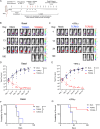LOXHD1 is an oncofusion-regulated antigen of ewing sarcoma
- PMID: 40234527
- PMCID: PMC12000433
- DOI: 10.1038/s41598-025-96877-9
LOXHD1 is an oncofusion-regulated antigen of ewing sarcoma
Abstract
Ewing Sarcoma (EwS) is a rare pediatric malignancy characterized by a unique t(11:22) (q24;q12) translocation resulting in the pathognomonic EWSR1::FLI1 fusion. Recent reports indicate that the EWSR1::FLI1 oncofusion drives aberrant expression of numerous transcripts, including Lipoxygenase Homology Domains 1 (LOXHD1). Given its highly restricted protein expression pattern and role in EwS tumorigenesis and metastasis, LOXHD1 may serve as a novel immunotherapeutic target in this malignancy. LOXHD1 immunogenic epitopes restricted to HLA-A*02:01 allowed for the isolation of a high avidity αβTCR. LOXHD1-specific TCR engineered CD8+ T cells conferred cytotoxic activity against a panel of HLA-A*02:01+ EwS tumor cell lines and adoptive transfer led to tumor eradication in a mouse xenograft model of EwS. This study nominates LOXHD1 as an oncofusion regulated, non-mutated tumor associated antigen (TAA) with expression limited to inner hair cells of the cochlea, adult testis, and EwS.
© 2025. The Author(s).
Conflict of interest statement
Declarations. Competing interests: T.B, I.A.A., G.P.L., and B.M.C. are inventors on a patent (63/516,178) related to the targeting of LOXHD1 for immunotherapy entitled “Compositions and Methods for Targeting LOXHD1-Associated Disease”. All other authors have no competing interest to declare.
Figures




References
-
- Grunewald, T. G. P. et al. Ewing sarcoma. Nat. Rev. Dis. Primers. 4, 5. 10.1038/s41572-018-0003-x (2018). - PubMed
-
- Pappo, A. S., Dirksen, U. Rhabdomyosarcoma, Ewing sarcoma, and other round cell sarcomas. J. Clin. Oncol.36, 168–179. 10.1200/JCO.2017.74.7402 (2018). - PubMed
-
- Stahl, M. et al. Risk of recurrence and survival after relapse in patients with ewing sarcoma. Pediatr. Blood Cancer. 57, 549–553. 10.1002/pbc.23040 (2011). - PubMed
-
- Gaspar, N. et al. Ewing sarcoma: current management and future approaches through collaboration. J. Clin. Oncol.33, 3036–3046. 10.1200/JCO.2014.59.5256 (2015). - PubMed
-
- Delattre, O. et al. Gene fusion with an ETS DNA-binding domain caused by chromosome translocation in human tumours. Nature359, 162–165. 10.1038/359162a0 (1992). - PubMed
MeSH terms
Substances
Grants and funding
LinkOut - more resources
Full Text Sources
Research Materials

